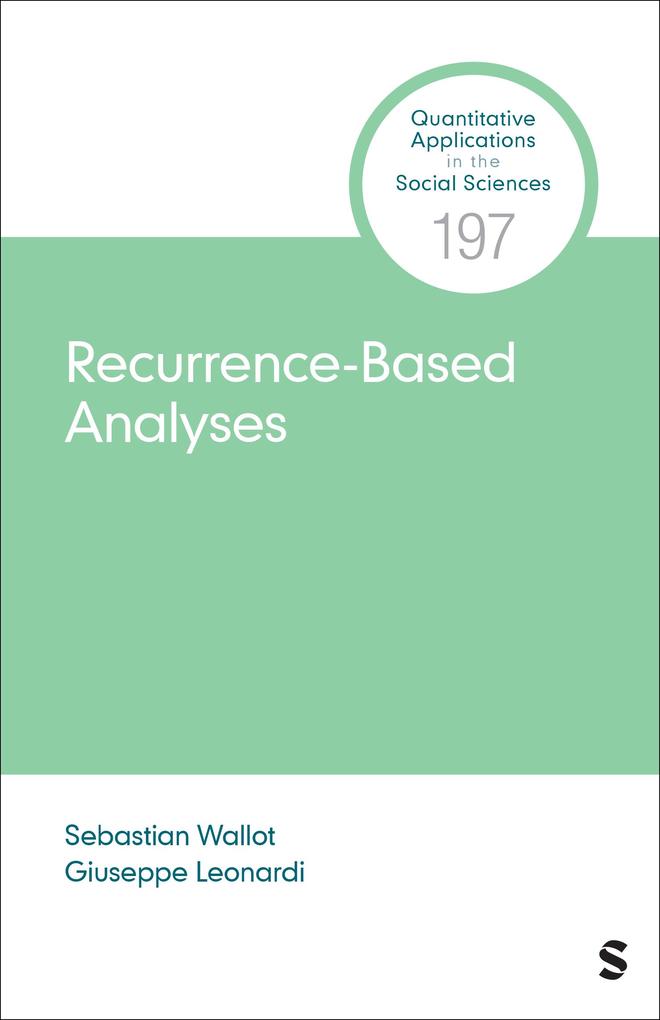
Zustellung: Do, 31.07. - Mi, 06.08.
Versand in 3-4 Wochen
VersandkostenfreiBestellen & in Filiale abholen:
This book introduces techniques developed in physics and physiology for characterizing and analyzing patterns in time series data to a broad audience of social scientists. The authors illustrate concepts and techniques with relevant social science examples at different temporal scales: biweekly polling data on federal elections in Germany; daily values of three stock market indices; daily cases of SarsCov-19 in four countries during the pandemic; and second-by-second vocalizations of mothers and infants interacting recorded by motion cameras.
Inhaltsverzeichnis
Series Editor Introduction
Acknowledgments
About the Authors
Acronyms and Notation
Chapter 1: What is Recurrence Analysis?
The Recurrence Plot
Deriving Recurrence Measures
Advantages and Limitations of Recurrence Analysis
Chapter 2: The Basics of Recurrence Analysis-Univariate RQA
Parameter Estimation
The Delay Parameter t
The Embedding Parameter m
The Radius Parameter e
Further Parameters
Summarizing RQA Outputs
Chapter 3: The Bi-Variate Case: Cross-Recurrence Quantification Analysis
Introduction to CRQA
Standardization
Alignment
The Cross-Recurrence Plot (CRP)
Using CRQA With Continuous Data: Stock Market Fluctuations
Using CRQA With Categorical Data
Chapter 4: The Diagonal-Wise Cross-Recurrence Profile (DCRP)
Diagonal-Wise Cross Recurrence Profiles (DCRP)
Building a Baseline by Means of Shuffling
Chapter 5: Windowed Recurrence Analysis
Introduction to Univariate Windowed Recurrence Analysis
Windowed Cross-Recurrence Analysis
Using Windowed Recurrence Analysis for Continuous Monitoring
Chapter 6: Multivariate Analysis: Multidimensional Recurrence Quantification Analysis (MdRQA)
Introduction to MdRQA
Multidimensional Cross-Recurrence Quantification Analysis (MdCRQA)
An Example Using Multidimensional RQA on Political Polling Data
Chapter 7: Sample Analysis and Practicalities
Calculating General Parameters
Time Series Length
Computing Confidence Bounds Via Boot-Strapping
Parameter Exploration
Surrogate Analysis
Dealing With Multiple Recurrence-Measures
Chapter 8: Conclusion
Further Applications
Finding Software
A Final Note
References
Index
Acknowledgments
About the Authors
Acronyms and Notation
Chapter 1: What is Recurrence Analysis?
The Recurrence Plot
Deriving Recurrence Measures
Advantages and Limitations of Recurrence Analysis
Chapter 2: The Basics of Recurrence Analysis-Univariate RQA
Parameter Estimation
The Delay Parameter t
The Embedding Parameter m
The Radius Parameter e
Further Parameters
Summarizing RQA Outputs
Chapter 3: The Bi-Variate Case: Cross-Recurrence Quantification Analysis
Introduction to CRQA
Standardization
Alignment
The Cross-Recurrence Plot (CRP)
Using CRQA With Continuous Data: Stock Market Fluctuations
Using CRQA With Categorical Data
Chapter 4: The Diagonal-Wise Cross-Recurrence Profile (DCRP)
Diagonal-Wise Cross Recurrence Profiles (DCRP)
Building a Baseline by Means of Shuffling
Chapter 5: Windowed Recurrence Analysis
Introduction to Univariate Windowed Recurrence Analysis
Windowed Cross-Recurrence Analysis
Using Windowed Recurrence Analysis for Continuous Monitoring
Chapter 6: Multivariate Analysis: Multidimensional Recurrence Quantification Analysis (MdRQA)
Introduction to MdRQA
Multidimensional Cross-Recurrence Quantification Analysis (MdCRQA)
An Example Using Multidimensional RQA on Political Polling Data
Chapter 7: Sample Analysis and Practicalities
Calculating General Parameters
Time Series Length
Computing Confidence Bounds Via Boot-Strapping
Parameter Exploration
Surrogate Analysis
Dealing With Multiple Recurrence-Measures
Chapter 8: Conclusion
Further Applications
Finding Software
A Final Note
References
Index
Mehr aus dieser Reihe
Produktdetails
Erscheinungsdatum
30. April 2025
Sprache
englisch
Seitenanzahl
152
Reihe
Quantitative Applications in the Social Sciences
Autor/Autorin
Giuseppe Leonardi, Sebastian Wallot
Verlag/Hersteller
Produktart
kartoniert
Gewicht
210 g
ISBN
9781071872338
Entdecken Sie mehr
Bewertungen
0 Bewertungen
Es wurden noch keine Bewertungen abgegeben. Schreiben Sie die erste Bewertung zu "Recurrence-Based Analyses" und helfen Sie damit anderen bei der Kaufentscheidung.




















